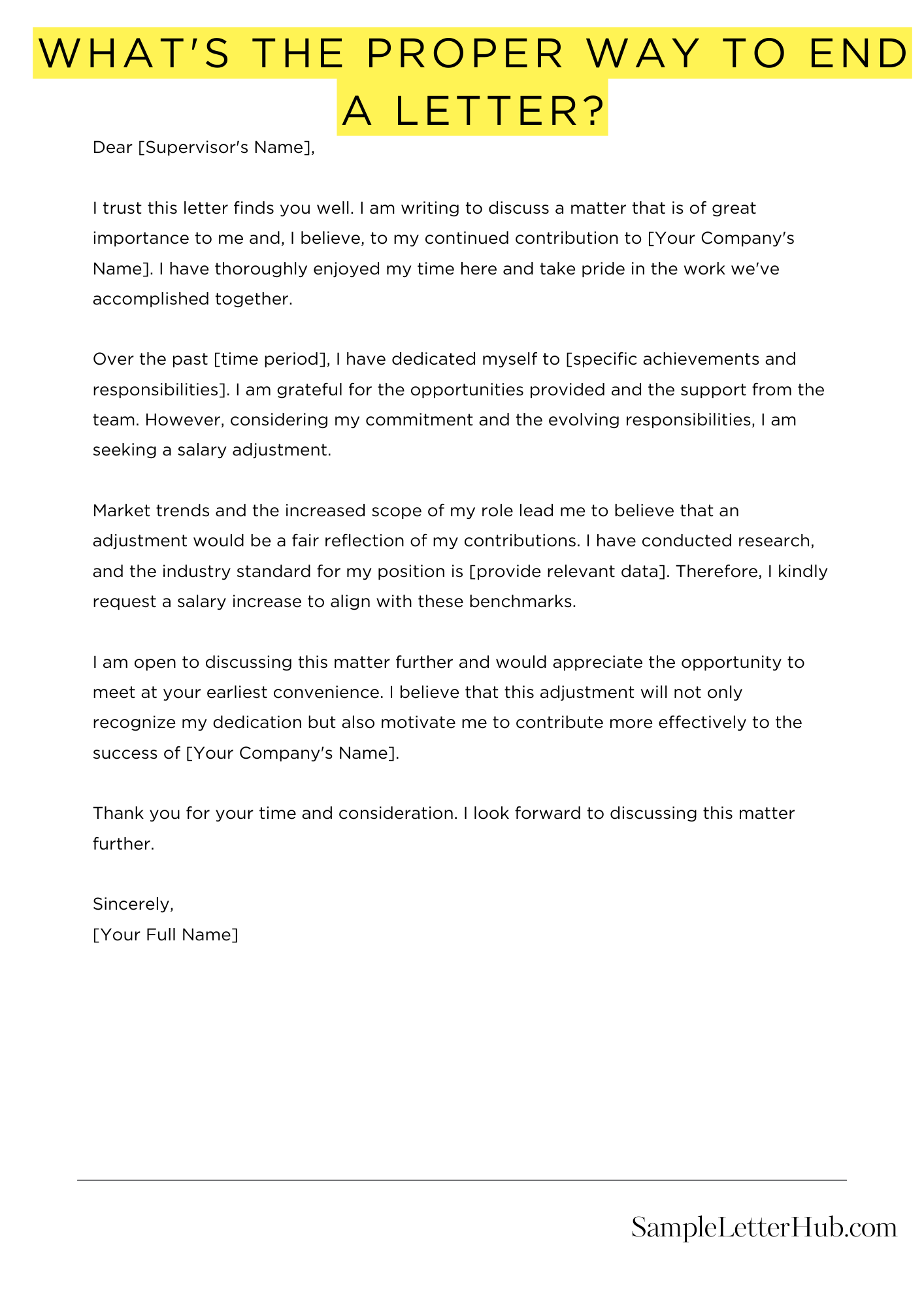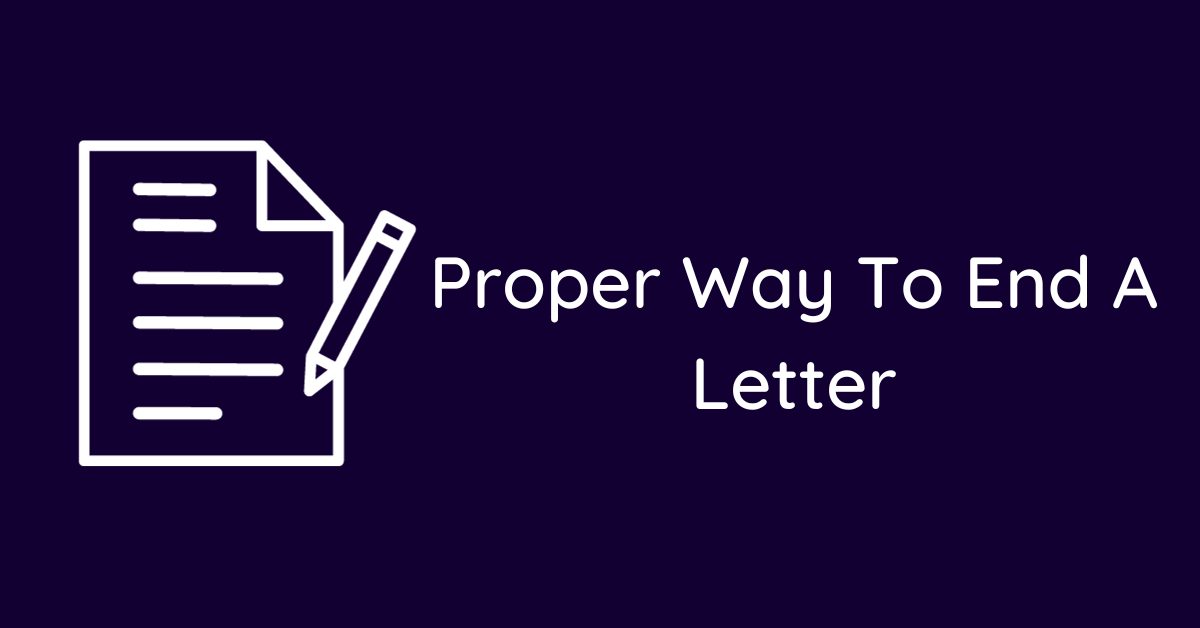Are you struggling to find the right way to end your letters? Look no further! In this blog article, we will provide you with the proper way to end a letter and its purpose.
Whether you are writing a formal letter or a personal one, it is important to end it on the right note to leave a lasting impression.
We understand that it can be challenging to find the right words to end a letter, which is why we have compiled a list of templates, examples, and samples for you to use.
Our goal is to make it easy for you to write any letter that you are trying to write. With our help, you can ensure that your letters end on a positive and professional note.
So, whether you are writing a letter to a friend, a colleague, or a potential employer, we have got you covered. Keep reading to learn more about the proper way to end a letter and how to use our templates and examples to make your writing process a breeze.
What is Proper Way To End A Letter?
Writing a letter is an art that has been around for centuries. It is a way to communicate with someone in a more personal and intimate way than through email or text messages. However, ending a letter can be tricky. You want to leave a lasting impression, but you don’t want to come across as too formal or too casual. In this article, we will discuss the proper way to end a letter.
1. Choose the Right Closing
The closing of a letter is the last thing the reader will see, so it’s important to choose the right one. The most common closings are “”Sincerely,”” “”Best regards,”” and “”Yours truly.”” These are safe options that work for most situations. However, if you want to add a personal touch, you can use a closing that reflects your relationship with the recipient. For example, “”With love,”” “”Warmly,”” or “”Cheers.””
2. Use Proper Punctuation
The closing of a letter should always be followed by a comma. For example, “”Sincerely,”” or “”Best regards,””. If you are using a more informal closing, such as “”Cheers,”” you can skip the comma. However, it’s important to remember that the first word of the closing should be capitalized.
3. Add a Signature
A letter is not complete without a signature. If you are sending a physical letter, you should sign your name in ink. If you are sending an email, you can use a digital signature. Your signature should be legible and easy to read.
4. Include Your Contact Information
If you want the recipient to be able to contact you, you should include your contact information in the letter. This can be your phone number, email address, or mailing address. If you are sending a physical letter, you should include your return address on the envelope.
5. Proofread Your Letter
Before you send your letter, it’s important to proofread it for errors. Check for spelling and grammar mistakes, as well as any typos. You want your letter to be professional and polished, so take the time to make sure it’s perfect.
6. Consider Adding a Postscript
A postscript, or P.S., is a great way to add a personal touch to your letter. It’s a short message that is added after the closing and signature.
Examples of Proper Way To End A Letter
Dear [Recipient’s Name],
I trust this letter finds you well and in good spirits. I wanted to take a moment to express my gratitude for your time and attention.
In closing, I would like to reiterate my appreciation for our ongoing collaboration. Your support and cooperation are invaluable, and I look forward to the positive outcomes that our joint efforts will undoubtedly yield.
Thank you once again for your kind consideration. Should you have any further questions or require additional information, please do not hesitate to reach out.
Wishing you continued success and looking forward to our future endeavors.
Warm regards
Your Name
Ways To End A Letter
Dear [Recipient’s Name],
As I conclude this letter, please allow me to express my sincere appreciation for your time and consideration.
In wrapping up, I want to extend my best wishes for your continued success and happiness. May your endeavors be fruitful and fulfilling.
Before I sign off, let me express my gratitude once again for your attention. I look forward to our future interactions and collaborations.
Best regards,
Your Name
Proper Way To End A Professional Letter
Dear [Recipient’s Name],
It has been a pleasure communicating with you. I appreciate the time and attention you’ve devoted to this matter.
As we draw this correspondence to a close, please feel free to reach out if you require any further information or clarification.
Thank you for your collaboration and understanding. I look forward to the opportunity for future engagements and continued success together.
Best regards,
Your Name
Proper Way To End A Letter To A Friend
Hey [Friend’s Name],
It’s been great catching up with you in this letter. I hope you’ve enjoyed reading it as much as I enjoyed writing it.
As I bring this letter to a close, know that our friendship means the world to me. Life gets busy, but our connection remains a cherished constant.
Looking forward to our next rendezvous, whether in words on paper or face-to-face. Until then, take care and stay awesome!
Warm regards,
Your Name
Proper Way To End A Application Letter
Dear Hiring Manager,
Thank you for considering my application for the [Position] at [Company]. It has been a pleasure to convey my qualifications and enthusiasm for the role.
As I conclude this letter, I want to reiterate my genuine interest in contributing my skills to your team. I am confident in my ability to bring valuable insights and dedication to the position.
I appreciate the opportunity to be considered for this role and look forward to the possibility of discussing how my experiences align with the needs of your organization in an interview.
Sincerely,
Your Full Name

FAQs About Proper Way To End A Letter
1. What is the most common way to end a letter?
The most common way to end a letter is with “”Sincerely”” or “”Yours truly.”” These are both formal and appropriate for professional letters. For personal letters, “”Best regards”” or “”Warm regards”” are more commonly used.
2. Can I use “”Love”” to end a letter?
“”Love”” is typically reserved for close friends and family members. It’s not appropriate to use in a professional setting or with someone you don’t know well. Instead, opt for a more formal closing such as “”Best regards”” or “”Sincerely.””
3. Should I include my full name in the closing?
It’s not necessary to include your full name in the closing if you’ve already signed your name at the end of the letter. However, if you’re writing a formal letter, it’s appropriate to include your full name and title.
4. Is it okay to use abbreviations in the closing?
Abbreviations such as “”Thx”” or “”BR”” are not appropriate for a formal letter. Stick to using the full words such as “”Thank you”” or “”Best regards.””
5. Can I use a quote or saying to end a letter?
Using a quote or saying can be a nice touch to end a letter, but make sure it’s appropriate for the context and the recipient. Avoid using quotes that are controversial or offensive.
6. What if I don’t know the recipient’s name?
If you don’t know the recipient’s name, you can use a generic closing such as “”Sincerely”” or “”Yours truly.”” If you’re writing a letter to a company, you can use “”Dear Sir/Madam”” and end with “”Yours faithfully.””
7. Is it necessary to include a closing at all?
While it’s not necessary to include a closing, it’s considered polite and professional to do so. It provides a clear ending to the letter and shows that you’ve put thought into the communication.
Related:

